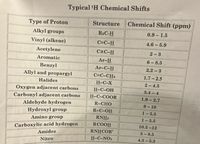
Chemistry
10th Edition
ISBN: 9781305957404
Author: Steven S. Zumdahl, Susan A. Zumdahl, Donald J. DeCoste
Publisher: Cengage Learning
expand_more
expand_more
format_list_bulleted
Concept explainers
Question
What would be the correct structure based on the following NMR data
Molecule formula: C8H8O2
- S:3.6ppm. Singlet,3H
- S:7.4ppm and 7.8 ppm doublet of doublets 4H total
-S:9.8ppm singlet,1H

Transcribed Image Text:Typical 'H Chemical Shifts
Type of Proton
Structure
Chemical Shift (ppm)
Alkyl groups
R3C-H
0.9 - 1.5
Vinyl (alkene)
C=C-H
4.6 – 5.9
Acetylene
C=C-H
2 - 3
Aromatic
Ar-H
6 - 8.5
Benzyl
Ar-C-H
2.2 - 3
Allyl and propargyl
C=C-CH3
1.7 – 2.5
Halides
Н-С-Х
2 - 4.5
Oxygen adjacent carbons
Н-С-ОН
3.4 - 4
Carbonyl adjacent carbons
H-C-COOR
1.9 – 2.7
Aldehyde hydrogen
R-CHO
9 - 10
Hydroxyl group
R-C-ОH
1- 5.5
Amino group
RNH2
1-5.5
Carboxylic acid hydrogen
Amides
RCOOH
10.5 -12
RNHCOR'
5-8.5
H-C-NO2
4.3 - 5.3
Nitro
Expert Solution
This question has been solved!
Explore an expertly crafted, step-by-step solution for a thorough understanding of key concepts.
This is a popular solution
Trending nowThis is a popular solution!
Step by stepSolved in 2 steps with 2 images

Knowledge Booster
Learn more about
Need a deep-dive on the concept behind this application? Look no further. Learn more about this topic, chemistry and related others by exploring similar questions and additional content below.Similar questions
- Identify the structure of the compound a with a formula of C3H6O2 having the following IR, and 1H NMR spectra (integrals and multiplicity shown in the boxes: s-singlet, d-doublet, t-triplet, q-quartet, etc.). Label the spectra with proper information you deduced (functional groups, number of protons, fragments, etc.). Compound formula. C3H6O2 Questions to help you decide What is the element of unsaturation of the molecular formula? Show the equation you use: What are the functional groups present in this molecule? Show all of them belowDraw at least two possible structures that have the . required element of unsaturation as well as the observed functional groups: Based on the 1H NMR above, what molecular fragmentations do you see: Draw your final decision of the structure below. Is this one of the structures in your answer 5C?arrow_forward7. Identify the structures for the following two isomers with molecular formula C10H12O2. There is an IR stretch at 1718 cm¹ for the compound in part a and 1740 cm¹ for the compound in part b. The 'H NMR spectra are shown below. a. b. 11 10 HSP-01-396 11 10 HSP-02-824 3 2 2 will 9 9 2 8 8 5 7 7 6 6 5 ppm 5 ppm 4 3 2 2 4 3 2 2 3 1 1 0 0arrow_forwardDraw the structure.arrow_forward
- Is it possible to distinguish compounds shown below by NMR? CI-CH2-CH2-CH3 VS 1-chloropropane CH3-CHCI-CH3 2-chloropropanearrow_forwardWhich of the following molecules: A. H₂C 0 CH₂ C. Ï_¶Ï H₂C B. H₂C A. acetone C. ethanol OH B. methyl acetate E. ethyl acetate D. diethyl ether is best represented by NMR spectra below? D. 20 H.C 17122 .CH₂₁ 14 E. H₂C 10 20 13Carrow_forwardWhich structure below best matches the following H NMR spectral data? 81.2 (triplet, 3H), 2.0 (quartet, 2H), 7.1 (singlet, 2H)arrow_forward
- Please explain how to solve the following NMR:arrow_forwardDraw the structure of the molecule with the following molecular formula, C3H¬CIO, and 'H NMR spectra (Chemical shift, multiplicity, #Hs): 2.0 ppm (quintet, 2H) 2.8 ppm (singlet, 1H) 3.7 ppm (triplet, 2H) 3.8 ppm (triplet, 2H)arrow_forwardwhat are the differences between metallic and covalent bond?arrow_forward
arrow_back_ios
arrow_forward_ios
Recommended textbooks for you
 ChemistryChemistryISBN:9781305957404Author:Steven S. Zumdahl, Susan A. Zumdahl, Donald J. DeCostePublisher:Cengage Learning
ChemistryChemistryISBN:9781305957404Author:Steven S. Zumdahl, Susan A. Zumdahl, Donald J. DeCostePublisher:Cengage Learning ChemistryChemistryISBN:9781259911156Author:Raymond Chang Dr., Jason Overby ProfessorPublisher:McGraw-Hill Education
ChemistryChemistryISBN:9781259911156Author:Raymond Chang Dr., Jason Overby ProfessorPublisher:McGraw-Hill Education Principles of Instrumental AnalysisChemistryISBN:9781305577213Author:Douglas A. Skoog, F. James Holler, Stanley R. CrouchPublisher:Cengage Learning
Principles of Instrumental AnalysisChemistryISBN:9781305577213Author:Douglas A. Skoog, F. James Holler, Stanley R. CrouchPublisher:Cengage Learning Organic ChemistryChemistryISBN:9780078021558Author:Janice Gorzynski Smith Dr.Publisher:McGraw-Hill Education
Organic ChemistryChemistryISBN:9780078021558Author:Janice Gorzynski Smith Dr.Publisher:McGraw-Hill Education Chemistry: Principles and ReactionsChemistryISBN:9781305079373Author:William L. Masterton, Cecile N. HurleyPublisher:Cengage Learning
Chemistry: Principles and ReactionsChemistryISBN:9781305079373Author:William L. Masterton, Cecile N. HurleyPublisher:Cengage Learning Elementary Principles of Chemical Processes, Bind...ChemistryISBN:9781118431221Author:Richard M. Felder, Ronald W. Rousseau, Lisa G. BullardPublisher:WILEY
Elementary Principles of Chemical Processes, Bind...ChemistryISBN:9781118431221Author:Richard M. Felder, Ronald W. Rousseau, Lisa G. BullardPublisher:WILEY

Chemistry
Chemistry
ISBN:9781305957404
Author:Steven S. Zumdahl, Susan A. Zumdahl, Donald J. DeCoste
Publisher:Cengage Learning

Chemistry
Chemistry
ISBN:9781259911156
Author:Raymond Chang Dr., Jason Overby Professor
Publisher:McGraw-Hill Education

Principles of Instrumental Analysis
Chemistry
ISBN:9781305577213
Author:Douglas A. Skoog, F. James Holler, Stanley R. Crouch
Publisher:Cengage Learning

Organic Chemistry
Chemistry
ISBN:9780078021558
Author:Janice Gorzynski Smith Dr.
Publisher:McGraw-Hill Education

Chemistry: Principles and Reactions
Chemistry
ISBN:9781305079373
Author:William L. Masterton, Cecile N. Hurley
Publisher:Cengage Learning

Elementary Principles of Chemical Processes, Bind...
Chemistry
ISBN:9781118431221
Author:Richard M. Felder, Ronald W. Rousseau, Lisa G. Bullard
Publisher:WILEY